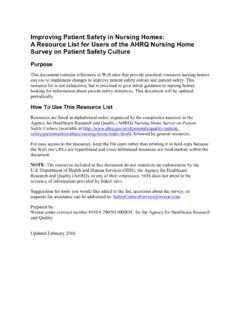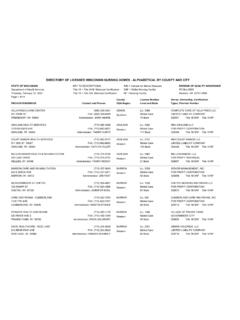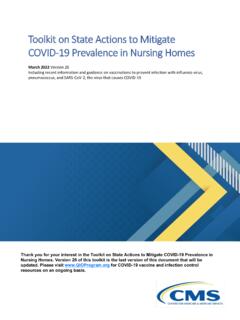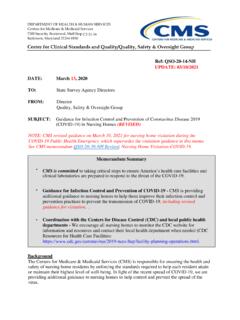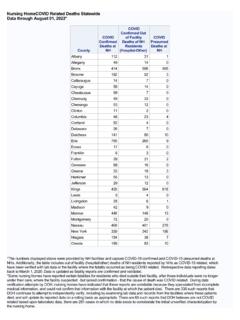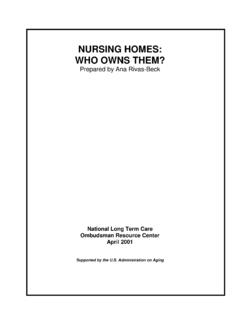Transcription of Nursing Homes - Centers for Disease Control and Prevention
1 Page 1 of 6 Accessible version: Implementation of Personal Protective Equipment in Nursing Homes to Prevent Spread of Novel or Targeted Multidrug-resistant Organisms (MDROs) Updated: July 29, 2019 Note: This Interim Guidance was updated on July 26, 2019 to clarify its current intended use as part of a Containment Response1. Future updates are anticipated to address potential for application of this approach outside of a Containment Response. Implementation of Contact Precautions, as described in the CDC Guideline for Isolation Precautions ( ), is perceived to create challenges for Nursing Homes trying to balance the use of personal protective equipment (PPE) and room restriction to prevent MDRO transmission with residents quality of life. Thus, current practice in many Nursing Homes is to implement Contact Precautions only when residents are infected with an MDRO and on treatment. Focusing only on residents with active infection fails to address the continued risk of transmission from residents with MDRO colonization, which can persist for long periods of time ( , months), and result in the silent spread of MDROs.
2 With the need for an effective response to the detection of serious antibiotic resistance threats, there is growing evidence that current implementation of Contact Precautions in Nursing Homes is not adequate for Prevention of MDRO transmission. This document is intended to provide guidance for PPE use and room restriction in Nursing Homes for preventing transmission of novel or targeted MDROs, including as part of a public health containment response ( ). This guidance introduces a new approach called Enhanced Barrier Precautions, which falls between Standard and Contact Precautions, and requires gown and glove use for certain residents during specific high-contact resident care activities2,3 that have been found to increase risk for MDRO transmission. This document is not intended for use in acute care or long-term acute care hospitals and does not replace existing guidance regarding use of Contact Precautions for other pathogens ( , Clostridioides difficile, norovirus) in Nursing Homes .
3 As of July 2019, Novel or Targeted MDROs are defined as: Pan-resistant organisms, Carbapenemase-producing enterobacteriaceae, Carbapenemase-producing Pseudomonas spp., Carbapenemase-producing Acinetobacter baumannii, and Candida auris Implementation of Personal Protective Equipment in Nursing Homes to Prevent Spread of MDROs Updated: July 29, 2019 Page 2 of 6 Description of Existing Precautions: Standard Precautions are a group of infection Prevention practices that apply to the care of all residents, regardless of suspected or confirmed infection or colonization status. They are based on the principle that all blood, body fluids, secretions and excretions (except sweat) may contain transmissible infectious agents. Proper selection and use of PPE, such as gowns and gloves, is one component of Standard Precautions, along with hand hygiene, safe injection practices, respiratory hygiene and cough etiquette, environmental cleaning and disinfection, and reprocessing of reusable medical equipment.
4 Use of personal protective equipment is based on the staff interaction with residents and the potential for exposure to blood, body fluid, or pathogens ( , gloves are worn when contact with blood, body fluids, mucous membranes, non-intact skin, or potentially contaminated surfaces or equipment are anticipated). More detail about Standard Precautions is available as part of the Core Infection Prevention and Control Practices for Safe Healthcare Delivery in all Settings ( ). Contact Precautions is one type of Transmission-Based Precaution that are used when pathogen transmission is not completely interrupted by Standard Precautions alone. Contact Precautions are intended to prevent transmission of infectious agents, like MDROs, that are spread by direct or indirect contact with the resident or the resident s environment. Contact Precautions requires the use of gown and gloves on every entry into a resident s room. The resident is given dedicated equipment ( , stethoscope and blood pressure cuff) and is placed into a private room.
5 When private rooms are not available, some residents ( , residents with the same pathogen) may be cohorted, or grouped together. Residents on Contact Precautions should be restricted to their rooms except for medically necessary care and restricted from participation in group activities. Because Contact Precautions require room restriction, they are generally intended to be time limited and, when implemented, should include a plan for discontinuation or de-escalation. More detail about Transmission-Based Precautions, including descriptions of Droplet Precautions and Airborne Precautions are available in the CDC Guideline for Isolation Precautions. In addition, other infections ( norovirus, Clostridioides difficile and scabies) and conditions for which Contact Precautions are indicated are summarized in Appendix A - Type and Duration of Precautions Recommended for Selected Infections and Conditions ( ) of the guideline. Description of New Precautions: Enhanced Barrier Precautions expands the use of PPE beyond situations in which exposure to blood and body fluids is anticipated, refers to the use of gown and gloves during high-contact resident care activities that provide opportunities for transfer of MDROs to staff hands and clothing 2,3.
6 Implementation of Personal Protective Equipment in Nursing Homes to Prevent Spread of MDROs Updated: July 29, 2019 Page 3 of 6 Examples of high-contact resident care activities requiring gown and glove use for Enhanced Barrier Precautions include: Dressing Bathing/showering Transferring Providing hygiene Changing linens Changing briefs or assisting with toileting Device care or use: central line, urinary catheter, feeding tube, tracheostomy/ventilator Wound care: any skin opening requiring a dressing Gown and gloves would not be required for resident care activities other than those listed above, unless otherwise necessary for adherence to Standard Precautions. Residents are not restricted to their rooms or limited from participation in group activities. Table: Summary of PPE Use and Room Restriction When Caring for Residents Colonized or Infected with Novel or Targeted MDROs in Nursing Homes : Precaution Applies to: PPE used for these situations: Required PPE Room restriction Standard Precautions All residents Any potential exposure to: Blood Body fluids Mucous membranes Non-intact skin Potentially contaminated environmental surfaces or equipment Depending on anticipated exposure: gloves, gown, or face protection (change PPE before caring for another resident) None Implementation of Personal Protective Equipment in Nursing Homes to Prevent Spread of MDROs Updated: July 29, 2019 Page 4 of 6 Precaution Applies to: PPE used for these situations: Required PPE Room restriction Enhanced Barrier Precautions All residents with any of the following: Infection or colonization with a novel or targeted MDRO when Contact Precautions do not apply.
7 Wounds and/or indwelling medical devices ( , central line, urinary catheter, feeding tube, tracheostomy/ventilator) regardless of MDRO colonization status who reside on a unit or wing where a resident known to be infected or colonized with a novel or targeted MDRO Facilities may consider applying Enhanced Barrier Precautions to residents infected or colonized with other epidemiologically-important MDROs based on facility policy. During high-contact resident care activities: Dressing Bathing/showering Transferring Providing hygiene Changing linens Changing briefs or assisting with toileting Device care or use: central line, urinary catheter, feeding tube, tracheostomy/ventilator Wound care: any skin opening requiring a dressing Gloves and gown prior to the high-contact care activity (change PPE before caring for another resident) (Face protection may also be needed if performing activity with risk of splash or spray) None Implementation of Personal Protective Equipment in Nursing Homes to Prevent Spread of MDROs Updated: July 29, 2019 Page 5 of 6 Precaution Applies to: PPE used for these situations: Required PPE Room restriction Contact Precautions All residents infected or colonized with a novel or targeted multidrug-resistant organism in any of the following situations.
8 Presence of acute diarrhea, draining wounds or other sites of secretions or excretions that are unable to be covered or contained On units or in facilities where ongoing transmission is documented or suspected For infections ( , C. difficile, norovirus, scabies) and other conditions where Contact Precautions is recommended see Appendix A - Type and Duration of Precautions Recommended for Selected Infections and Conditions of the CDC Guideline for Isolation Precautions Any room entry Gloves and gown (don before room entry, doff before room exit; change before caring for another resident) (Face protection may also be needed if performing activity with risk of splash or spray) Yes, except for medically necessary care Decisions regarding the use of additional practices to prevent the spread of MDROs can be determined in conjunction with public health. These strategies might differ depending on the prevalence or incidence of the MDRO in the facility and region.
9 Visit State-based HAI Prevention ( ) to find contact information for your state health department HAI program. Implementation: When implementing Contact Precautions or Enhanced Barrier Precautions, it is critical to ensure that staff have awareness of the facility s expectations about hand hygiene and gown/glove use, initial and refresher training, and access to appropriate supplies. To accomplish this: Post clear signage on the door or wall outside of the resident room indicating the type of Precautions and required PPE ( , gown and gloves). See Example Signs (Posters) ( #anchor_1564058318) o For Enhanced Barrier Precautions, signage should also clearly indicate the high-contact resident care activities that require the use of gown and gloves. See Enhanced Barrier Precautions Implementation of Personal Protective Equipment in Nursing Homes to Prevent Spread of MDROs Updated: July 29, 2019 Page 6 of 6 Example Sign [PDF - 1 page] ( ) Make PPE, including gowns and gloves available immediately outside of the resident room Ensure access to alcohol-based hand rub in every resident room (ideally both inside and outside of the room) Position a trash can inside the resident room and near the exit for discarding PPE after removal, prior to exit of the room or before providing care for another resident in the same room Incorporate periodic monitoring and assessment of adherence to determine the need for additional training and education Provide education to residents and visitors Note: Prevention of MDRO transmission in Nursing Homes requires more than just proper use of PPE and room restriction.
10 Guidance on implementing other recommended infection Prevention practices ( , hand hygiene, environmental cleaning, proper handling of wounds, indwelling medical devices, and resident care equipment) are available in CDC s free online course The Nursing home Infection Preventionist Training ( ). Nursing Homes are encouraged to have staff review relevant modules and to use the resources provided in the training ( , policy and procedure templates, checklists) to assess and improve practices in their facility. References: 1. CDC Containment Strategy Responding to Emerging AR Threats ( ) 2. Roghmann MC, Johnson JK, Sorkin JD, Langenberg P, Lydecker A, Sorace B, Levy L and Mody L. Transmission of Methicillin-Resistant Staphylococcus aureus (MRSA) to Healthcare Worker Gowns and Gloves During Care of Nursing home Residents Infect Control Hosp Epidemiol. 2015 Sep;36(9):1050-7. doi: 3. Blanco N, Pineles L, Lydecker AD, Johnson JK, Sorkin JD, Morgan DJ; VA Gown and Glove Investigators, Roghmann MC.










